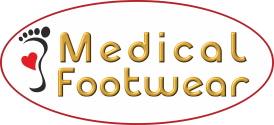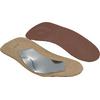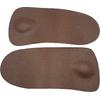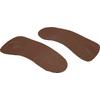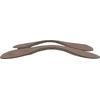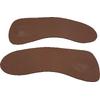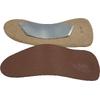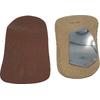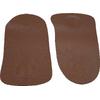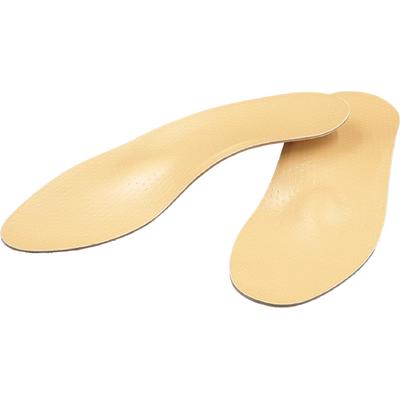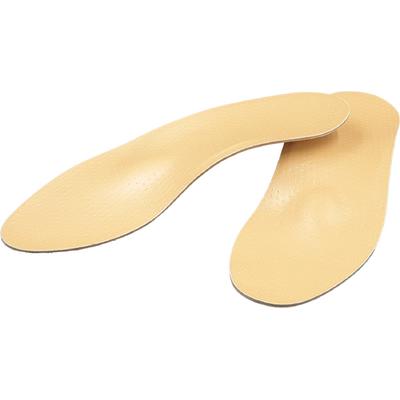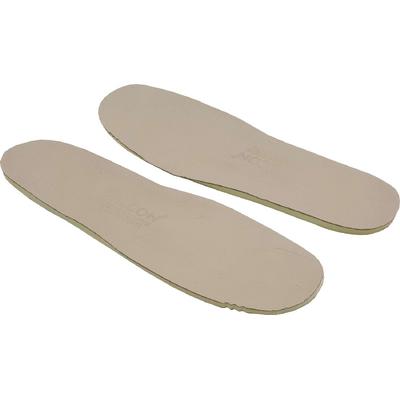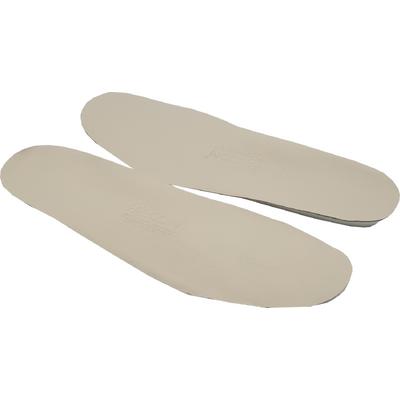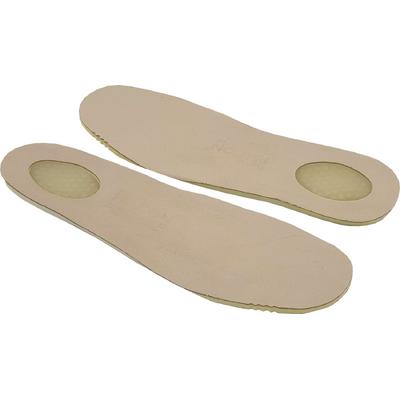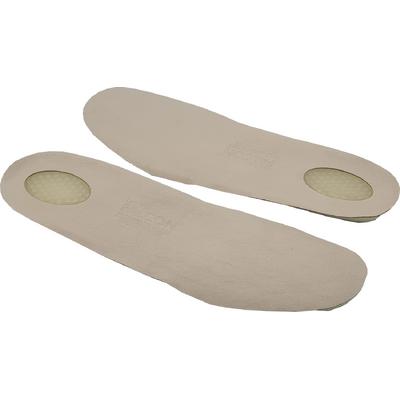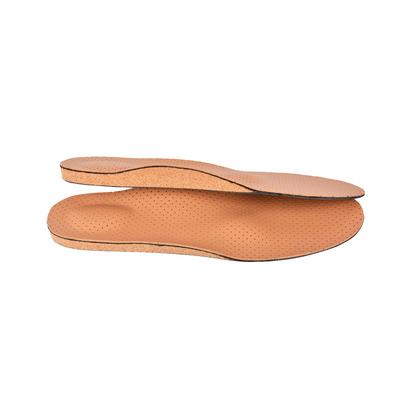Unisex Insole Size
|
TELEFONDA SİPARİŞ VER
+90 212 671 20 21
Tıklayın, telefonunuzu bırakın. Sizi arayalım.
Steel Insole for Flat Feet and Pes Cavus
What is steel insole features?
► it is antibacterial
► Do not sweat and hygiene
► Orthopedic properties
► Half base insoles
► Brand: Falcon
► Number range is 35 to 46
► Made in Türkiye
► Suitable for patients with high arch and flat feet.
► Used in support of the arch zone.
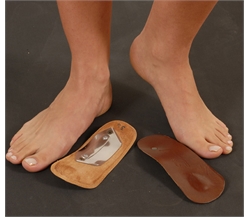
Steel Insole For Flat Feet With Arch Support
Steel insoles, also known as rigid or firm orthotic insoles, are specialized footbeds designed to provide strong support and stability to the foot. These insoles are made of durable materials, typically a combination of steel and other supportive components. Here are some common features of steel insoles:
► Rigid Arch Support: Steel insoles have a solid and unyielding arch support to help lift and maintain the arch of the foot, particularly in cases of flat feet and pes cavus.
► Durable Construction: The steel component in the insole provides exceptional durability and resistance to wear and tear, making them long-lasting and suitable for everyday use.
► Foot Alignment: Steel insoles help in maintaining proper foot alignment, reducing overpronation (excessive inward rolling) in flat feet and supination (outward rolling) in pes cavus.
► Pressure Redistribution: The firm support of steel insoles helps redistribute pressure across the foot, reducing pressure points and alleviating foot pain and fatigue.
► Stability and Balance: Steel insoles provide enhanced stability and balance, especially for individuals with foot deformities or gait abnormalities.
► Impact Absorption: While steel insoles are rigid, they often include cushioning materials that offer some shock absorption, improving comfort during walking or running.
► Versatility: Steel insoles can fit into various types of shoes, including athletic shoes, casual footwear, and work boots.
► Customizable Options: Some steel insoles can be custom-molded to the contours of an individual's foot, providing a more personalized fit and support.
► Medical Use: Steel insoles are often recommended by healthcare professionals for conditions like flat feet, pes cavus, plantar fasciitis, and other foot-related issues.
It's important to note that steel insoles might not be suitable for everyone, as some individuals may find them too rigid or uncomfortable. It's advisable to consult with a healthcare professional, such as a podiatrist or orthopedic specialist, to determine the most appropriate type of insole for individual needs and foot conditions.
How can I choose my foot size?
* When choosing the insole size, you can choose it by taking into account the size of the shoes you wear on a regular basis. Since it is half insoles, it is placed in the heel part of the shoe and the toe tips remain empty.
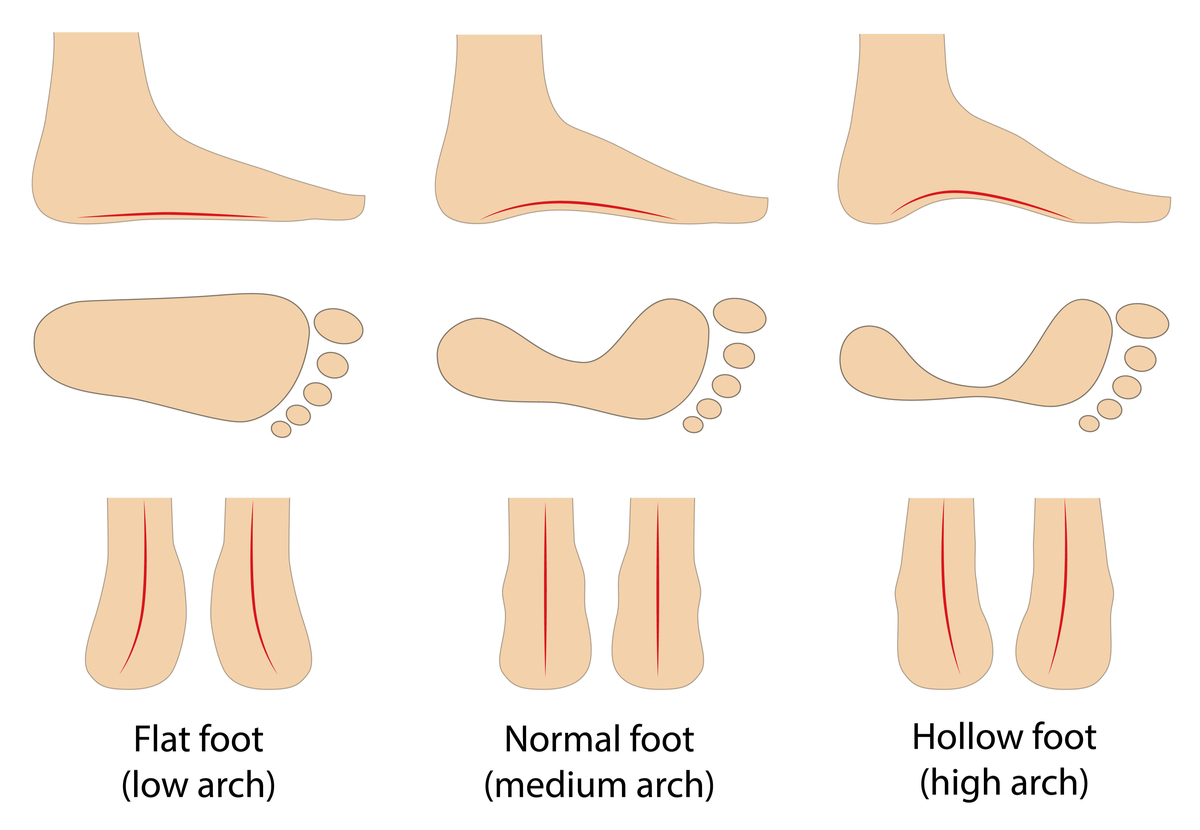
Who can use steel insole for Flat Foot
• Individuals with Mild to Moderate Flat Feet: Insoles can help support the arch and provide cushioning, which can be particularly beneficial for individuals with flexible flat feet or mild to moderate flatfoot conditions.
• Those Experiencing Foot Pain or Discomfort: Insoles can help reduce foot pain and discomfort caused by the lack of arch support in flat feet. They can redistribute pressure on the foot and provide cushioning to alleviate soreness and fatigue.
• People with Overpronation: Overpronation is a common issue in individuals with flat feet, where the foot rolls excessively inward during walking or running. Insoles with arch support can help control excessive pronation and improve gait mechanics.
• Athletes and Active Individuals: Insoles can provide additional support and shock absorption during physical activities, reducing the risk of foot and lower limb injuries associated with flat feet.
• Those Seeking Improved Foot Alignment: Insoles can help realign the foot and ankle, promoting better posture and reducing strain on the feet and lower limbs.
• Individuals with Uneven Shoe Wear Patterns: Flat feet can lead to uneven shoe wear patterns, particularly on the inner side of the shoe. Insoles can help correct this wear pattern and prolong the life of footwear.
* Flat feet or pes cavus foot problems can use our arch supported insoles.
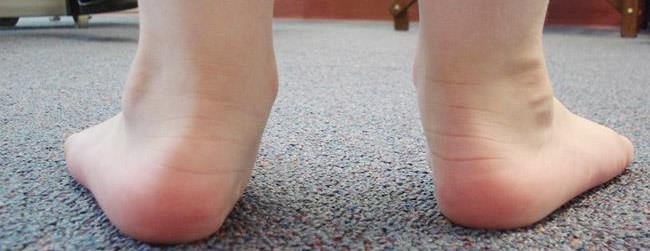
What is Flat Foot?
Flatfoot, also known as pes planus or fallen arches, is a common foot condition where the arch of the foot is lower than normal or entirely absent when standing. In individuals with flat feet, the entire sole of the foot makes contact with the ground. Flatfoot can occur in one or both feet and may be present from birth or develop later in life.
There are two main types of flatfoot:
Flexible Flatfoot: In this type, the arch appears when the foot is not bearing weight, but it flattens when the person stands. Flexible flatfoot is common in children and usually resolves on its own as they grow and their foot structures develop.
Rigid Flatfoot: In this type, the arch remains flattened, even when the foot is not bearing weight. Rigid flatfoot may be caused by a structural abnormality or a problem with the foot's bones, tendons, or ligaments. It is less common and may require medical intervention or specialized orthopedic footwear.
What Are Flat Feet Indications?
• Flat feet, also known as pes planus, may present with various indications, ranging from mild to severe. Here are some common indications of flat feet:
• Visible Flattened Arch: When standing, the arch of the foot appears lower or may be entirely absent, and the sole of the foot makes full or near-full contact with the ground.
• Foot Pain: Individuals with flat feet may experience pain or discomfort in the arch, heel, or along the inner side of the foot. The pain may worsen with prolonged standing, walking, or physical activity.
• Swelling: Some people with flat feet may experience swelling along the inside of the ankle, particularly after periods of activity.
• Tired Feet: Flat feet can cause feet to feel tired or achy after standing or walking for extended periods.
• Foot Fatigue: Individuals with flat feet may experience fatigue or muscle cramps in the feet and legs due to the altered alignment of the foot.
• Overpronation: Flat feet can lead to overpronation, where the foot rolls excessively inward during walking or running, affecting gait mechanics.
• Shoe Wear Patterns: Uneven or excessive wear on the inner side of the shoes is common in individuals with flat feet due to the uneven distribution of weight.
• Reduced Arch Height in Non-Weight Bearing Position: When the individual sits or lies down, the arch of the flat foot may not rise as much as typical feet do, even when not bearing weight.
• Foot Instability: Flat feet may lead to reduced foot stability, making it more challenging to balance and causing potential issues during physical activities.
It is important to note that not all individuals with flat feet will experience symptoms, and some people may have flexible flat feet that resolve naturally during growth and development. However, if flat feet are causing discomfort, pain, or mobility issues, it's essential to seek advice from a healthcare professional, such as a podiatrist or orthopedic specialist, for an accurate diagnosis and appropriate management. Treatment options may include supportive footwear, orthotic inserts, physical therapy, or other interventions depending on the severity and impact on daily activities.
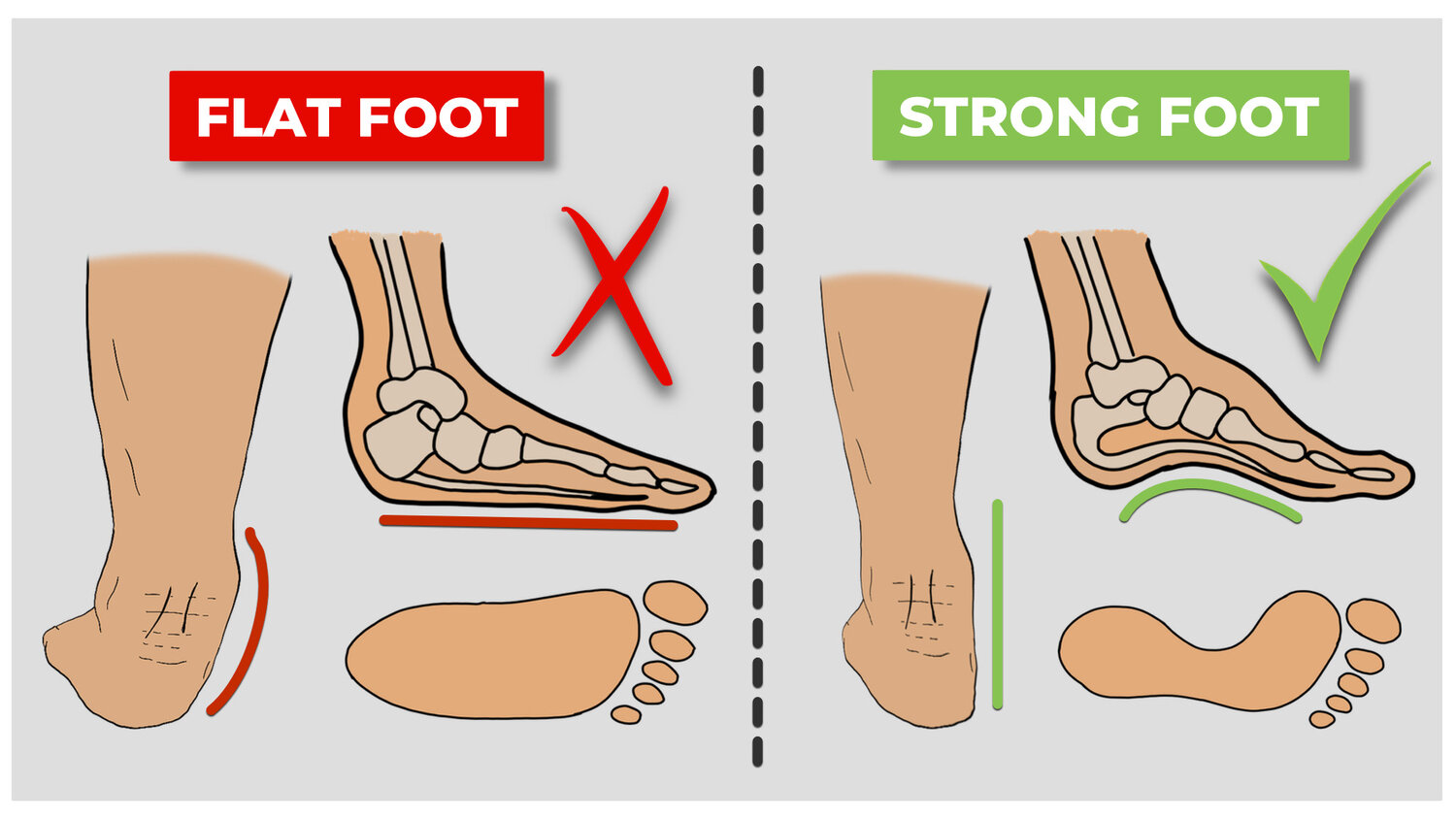
What is Pes Cavus?
Pes cavus, also known as high arches, is another foot condition characterized by an abnormally high arch of the foot when standing. In individuals with pes cavus, only the ball of the foot and the heel make contact with the ground. The arch is higher and more pronounced than the normal foot arch.
Like flatfoot, pes cavus can also be flexible or rigid:
Flexible Pes Cavus: The arch appears even higher when the foot is not bearing weight, but it may partially flatten when standing or walking.
Rigid Pes Cavus: The arch remains high and rigid, with minimal flattening when standing or walking
Pes cavus can be caused by various factors, such as neurological conditions, hereditary factors, or muscle imbalances. Depending on the severity and underlying cause, pes cavus may lead to foot pain, instability, and difficulties with walking or wearing regular footwear.
Both flatfoot and pes cavus may require appropriate footwear, orthotics, or other interventions to address any discomfort or walking issues associated with these conditions. It's essential to consult with a qualified healthcare professional or podiatrist for an accurate diagnosis and personalized treatment plan.
What are Pes Cavus Indications?
► Pes cavus, also known as high arches, may present with various indications, ranging from mild to severe. Here are some common indications of pes cavus:
► High Arch: The most apparent indication of pes cavus is an abnormally high arch of the foot when standing, with only the ball of the foot and the heel making contact with the ground.
► Claw-Like Appearance: The foot may appear more curved or claw-like due to the elevated arch.
► Foot Pain: Individuals with pes cavus may experience pain or discomfort on the ball of the foot, the heel, or along the outside edge of the foot. Pain may worsen with prolonged standing, walking, or physical activity.
► Foot Instability: Pes cavus can lead to reduced foot stability, making it more challenging to balance and causing potential issues during physical activities.
► Difficulty Finding Properly Fitting Shoes: Due to the high arch shape, individuals with pes cavus may have difficulty finding shoes that fit comfortably and provide adequate support.
► Calluses or Corns: The increased pressure on specific areas of the foot can lead to the development of calluses or corns.
► Ankle Instability: The elevated arch may contribute to ankle instability and an increased risk of ankle sprains.
► Foot Fatigue: Pes cavus can cause foot fatigue or muscle cramps in the feet and legs due to the altered foot alignment.
► Gait Abnormalities: Pes cavus may lead to gait abnormalities, such as supination, where the foot rolls outward during walking or running.
It's important to note that not all individuals with pes cavus will experience symptoms, and some people may have flexible pes cavus where the arch appears more pronounced when the foot is not bearing weight, but it partially flattens when standing or walking. However, if pes cavus is causing discomfort, pain, or mobility issues, it's essential to seek advice from a healthcare professional, such as a podiatrist or orthopedic specialist, for an accurate diagnosis and appropriate management. Treatment options may include supportive footwear, orthotic inserts, physical therapy, or other interventions depending on the severity and impact on daily activities.
Also visit flat foot footwear for best arch support shoes for flat foot and pes cavus
Can I shop safely on your site?
All purchases you make through https://www.medicalfootwear.net use the latest technologies and the best service provider for your safety.
Once you enter your credit card number under SSL security, you can be sure that no one will have access to this information. No one can view or access your information except you. The information about your number is encrypted and sent to your bank if you enter your credit card number. Your information can not be accessed by third parties, including https://www.medicalfootwear.net in this sense. Your card information is only known and protected by you and your bank.
Product price : 89.00 USD
| N****** S****** | |
| 20 February 2024 | |
Good products for arch support | |
When are orders shipped?
Products are generally shipped within 1-5 business days.
When will my order be delivered?
Products shipped are usually delivered to your address within 3-7 business days.
We ship with Fedex, DHL, UPS adn TNT, which are the leading cargo companies of express courier transportation. If you have a different request, please contact our company.
Where can I track my order?
You can track your order in the “my orders” section on our website. In addition, you can track the shipment directly by clicking on the link that is sent to your email address.
I cannot access the tracking information for my order. What am I supposed to do?
You need to contact us directly or through our support department if you encounter such a problem.
Which regions do you ship to?
You can shop online from anywhere in the world.
Safe Shopping
Free Shipping
Shipping Within 1-5 Days
Best Quality Products
These Products May Be Interested
Diabetic Insole for Womens OBT
79.00 USDDiabetic Insole for Mens OET
79.00 USD
Best Selling Products
Diabetic Insole for Mens OET
79.00 USDDiabetic Insole for Womens OBT
79.00 USD
